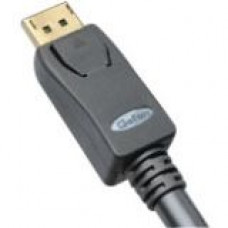Shopping Cart
0 item(s) - $0.00- Accortec, Inc.
- Addon Tech
- Advantech Co., Ltd
- Axiom
- BLACKBOX
- C2g
- Chief Manufacturing
- Cisco
- Dell
- EATON
- EMC
- Enet Components, Inc.
- Fortinet
- Getac, Inc
- HP
- HPE
- IBM
- Intel
- Legrand Group
- Lenovo
- Lexmark
- Middle Atlantic Products, Inc
- Monoprice, Inc
- National Products, Inc
- Panduit Corp
- StarTech.com
- Supermicro
- TDK
- Tripp Lite
- Veritas Technologies Llc
Gefen DisplayPort Cable 6 ft (M-M) - 6 ft DisplayPort A/V Cable - First End: 1 x DisplayPort Male Digital Audio/Video - Second End: 1 x DisplayPort Male Digital Audio/Video CAB-DPN-06MM
Add to Compare
Like its cousin HDMI but intended more as a computer-oriented complement, the new DisplayPort standard was created in 2007 by the Video Electronics Standards Association (VESA) to define a more advanced method of carrying AV signal data. DisplayPort cables can carry both digital DVI and analog VGA signals within the same cable along with 24-bit audio and USB -- at farther distances and less expensively than other cable types. Thanks to efficient design considerations, DisplayPort has achieved breakthroughs in lower costs and ease of use. DisplayPort''s freely licensed 128-bit copy protection scheme further open up new possibilities for AV enthusiasts, installers and developers alike while retaining legacy support for the 40-bit HDCP standard.
Technical Specifications:
Cable Type: DisplayPortCable Length: 6 ftConnector Type on First End: DisplayPort Digital Audio/Video - MaleConnector on First End Details: 1 x DisplayPort Digital Audio/Video - MaleConnector Type on Second End: DisplayPort Digital Audio/Video - MaleConnector on Second End Details: 1 x DisplayPort Digital Audio/Video - Male
Write a review
Your Name:Your Review: Note: HTML is not translated!
Rating: Bad Good
Enter the code in the box below:


